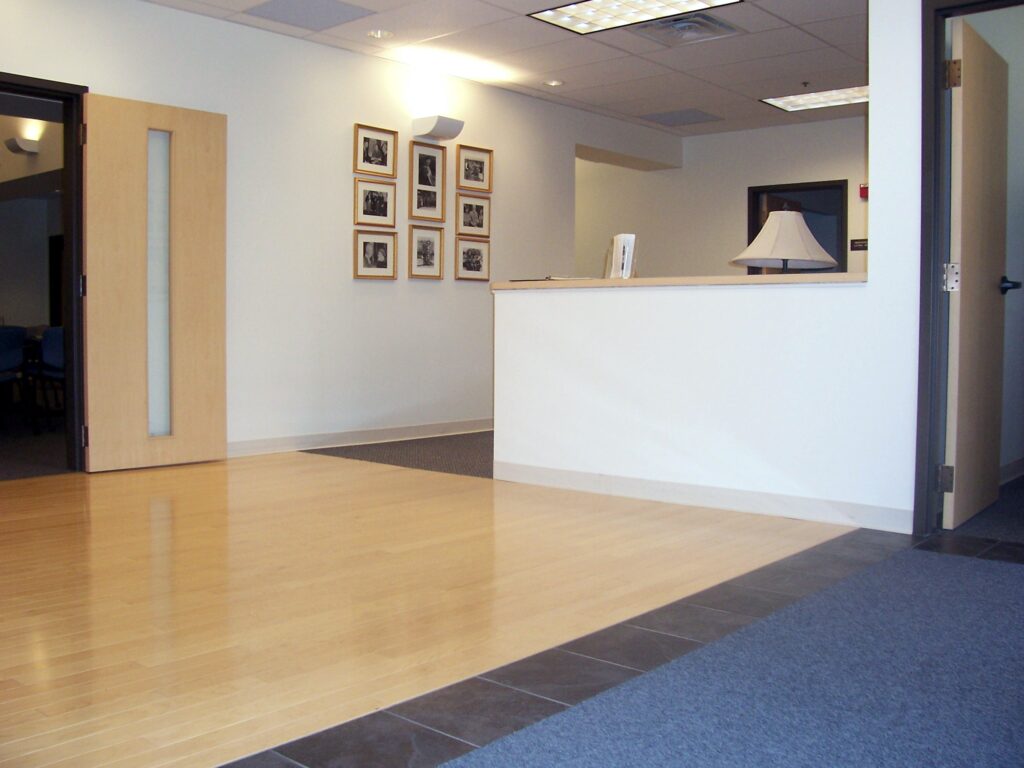Checklist for Choosing a Senior Living Community
Choosing a senior living community includes several important considerations for individuals who are blind or low vision. Furthermore, older people are at higher risk for age-related vision problems, and it makes sense to keep these suggestions in mind when making a decision. The checklist is also useful for senior living staff or planners.
 Example of Contrasting flooring with Varying Textures
Example of Contrasting flooring with Varying Textures
Environmental barriers include
- Hallways that intersect at odd angles
- Large open spaces with few landmarks that help with wayfinding and echoes that make it hard to hear
- Multiple sets of elevators that could be easily confused
- High gloss floors that create glare
- Low and/or uneven lighting in common areas, stairwells, and hallways
- Throw rugs or waxed or slippery floors
- Patterned carpeting that increases visual clutter
- Low lying furniture such as coffee tables
Environmental designs that promote functional vision and safety
- Color and/or texture contrast in flooring and baseboard choices
- Well-marked curbs and the edges of steps
- Use of dimmer switches, low-gloss flooring and tabletops, and window coverings to control glare in communal areas
- Signage in large print with high contrast as well as in braille
- Use of color-contrasting light switches, doorway trim, and handrails
- Large, contracting print or tactile markings on mailboxes
- Well-lit area surrounding mailboxes
- Elevators with braille and large-print signage and voice instructions to indicate arrival, departure, and floor
Staff Knowledge
- Does the staff have knowledge of vision loss?
- Does staff know about local rehabilitation services and refer as necessary?
- Do staff members know and provide human guide technique if requested?
- If not, is the administration committed to providing training to the staff on an ongoing basis? (see aging and vision loss toolkit)
Dining Area/Services
- Are residents encouraged to eat in the community setting?
- If so, are accommodations made?
- If not, will food be delivered to the room, if desired?
Suggested Accommodations in the Dining Area
- Will staff members provide assistance to get to the dining room if needed?
- Is glare control possible?
- Do the tables and chairs contrast with the flooring?
- Do the dishes and tables contrast with each other?
- Is food served cafeteria style or restaurant style?
- Do they have readable menus or someone to read the menu aloud?
- Is the wait staff trained to assist individuals who are blind or low vision?
- Do they identify what is being served and describe the location of each food on the plate?
- Do they place glasses, bowls, etc., in the same place each time?
Vision Related Services
- Do they have talking books, electronic magnifiers, accessible computers, large print books, or games specifically for residents who are blind or low vision?
- Can they assist with assistive devices or products the resident already owns?
- Will they provide a large print activity schedule on paper with good contrast?
- Do they have a low-vision support group, or are they willing to set one up if requested?
- Is their recreation equipment marked with tactile dots so that someone with vision loss can use it?
- Are volunteers or a reading service available to help with bills, important correspondence, and shopping?
Individual Living Areas
- Are doors to apartments or rooms easy to find—large print and braille numbers, use of contrasting doors and frames?
- Do the floors, walls, and furniture contrast with each other
- Are the refrigerator, thermostat, microwave, or stove marked with high contrast or tactile dots?
- Are call bells easily accessible and marked for visibility and ease of use?
- Is it possible to control glare with blinds or rheostats on lights?
- Are there enough lighting options to allow for reading in desirable areas?
- Is there good color contrast between the floor, the walls, and the fixtures in the bathroom?
- Can reflected glare be minimized on shiny surfaces?
- Do the grab bars contrast with the background in the tub/shower?
- Are washers and dryers marked for ease of use?
- Have the household staff been trained to not move things around in a resident’s room and on how to provide simple directions?
Transportation Services
- Are accessible vehicles provided for medical appointments, shopping, and/or other destinations?
- Is accessible public transportation available?
- Have transportation staff been trained in the use of human guide?
Learn More